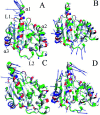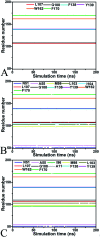Dynamics revelation of conformational changes and binding modes of heat shock protein 90 induced by inhibitor associations
- PMID: 35539786
- PMCID: PMC9082529
- DOI: 10.1039/c8ra05042b
Dynamics revelation of conformational changes and binding modes of heat shock protein 90 induced by inhibitor associations
Abstract
Heat shock protein 90 (Hsp90) has been an attractive target of potential drug design for antitumor treatment. The current work integrates molecular dynamics (MD) simulations, calculations of binding free energy, and principal component (PC) analysis with scanning of inhibitor-residue interaction to probe the binding modes of inhibitors YK9, YKJ and YKI to Hsp90 and identify the hot spot of the inhibitor-Hsp90 binding. The results suggest that the introductions of two groups G1 and G2 into YKJ and YKI strengthen the binding ability of YKJ and YKI to Hsp90 compared to YK9. PC analysis based MD trajectories prove that inhibitor bindings exert significant effects on the conformational changes, internal dynamics and motion modes of Hsp90, especially for the helix α2 and the loops L1 and L2. The calculations of residue-based free energy decomposition and scanning of the inhibitor-Hsp90 interaction suggest that six residues L107, G108, F138, Y139, W162 and F170 construct the common hot spot of the inhibitor-residue interactions. Moreover the substitutions of the groups G1 and G2 in YKJ and YKI lead to two additional hydrogen bonding interactions and multiple hydrophobic interactions for bindings of YKJ and YKI to Hsp90. This work is also expected to contribute theoretical hints for the design of potent inhibitors toward Hsp90.
This journal is © The Royal Society of Chemistry.
Conflict of interest statement
There are no conflicts to declare.
Figures









Similar articles
-
Understanding conformational diversity of heat shock protein 90 (HSP90) and binding features of inhibitors to HSP90 via molecular dynamics simulations.Chem Biol Drug Des. 2020 Jan;95(1):87-103. doi: 10.1111/cbdd.13623. Epub 2019 Oct 23. Chem Biol Drug Des. 2020. PMID: 31560152
-
Decoding molecular mechanism of inhibitor bindings to CDK2 using molecular dynamics simulations and binding free energy calculations.J Biomol Struct Dyn. 2020 Mar;38(4):985-996. doi: 10.1080/07391102.2019.1591304. Epub 2019 Apr 2. J Biomol Struct Dyn. 2020. PMID: 30843759
-
Binding modes and conformational changes of FK506-binding protein 51 induced by inhibitor bindings: insight into molecular mechanisms based on multiple simulation technologies.J Biomol Struct Dyn. 2020 Apr;38(7):2141-2155. doi: 10.1080/07391102.2019.1624616. Epub 2019 Jun 14. J Biomol Struct Dyn. 2020. PMID: 31198099
-
C-terminal modulators of heat shock protein of 90 kDa (HSP90): State of development and modes of action.Bioorg Med Chem. 2019 Nov 1;27(21):115080. doi: 10.1016/j.bmc.2019.115080. Epub 2019 Aug 26. Bioorg Med Chem. 2019. PMID: 31519378 Review.
-
Binding of natural and synthetic inhibitors to human heat shock protein 90 and their clinical application.Medicina (Kaunas). 2011;47(8):413-20. Epub 2011 Nov 18. Medicina (Kaunas). 2011. PMID: 22123555 Review.
Cited by
-
Heat shock protein 90: biological functions, diseases, and therapeutic targets.MedComm (2020). 2024 Jan 25;5(2):e470. doi: 10.1002/mco2.470. eCollection 2024 Feb. MedComm (2020). 2024. PMID: 38283176 Free PMC article. Review.
-
Binding Mechanism of Inhibitors to Heat Shock Protein 90 Investigated by Multiple Independent Molecular Dynamics Simulations and Prediction of Binding Free Energy.Molecules. 2023 Jun 15;28(12):4792. doi: 10.3390/molecules28124792. Molecules. 2023. PMID: 37375347 Free PMC article.
-
Effective Estimation of Ligand-Binding Affinity Using Biased Sampling Method.ACS Omega. 2019 Feb 21;4(2):3887-3893. doi: 10.1021/acsomega.8b03258. eCollection 2019 Feb 28. ACS Omega. 2019. PMID: 31459599 Free PMC article.
-
Binding selectivity of inhibitors toward the first over the second bromodomain of BRD4: theoretical insights from free energy calculations and multiple short molecular dynamics simulations.RSC Adv. 2020 Dec 24;11(2):745-759. doi: 10.1039/d0ra09469b. eCollection 2020 Dec 24. RSC Adv. 2020. PMID: 35423696 Free PMC article.
-
Binding Selectivity of Inhibitors toward Bromodomains BAZ2A and BAZ2B Uncovered by Multiple Short Molecular Dynamics Simulations and MM-GBSA Calculations.ACS Omega. 2021 Apr 28;6(18):12036-12049. doi: 10.1021/acsomega.1c00687. eCollection 2021 May 11. ACS Omega. 2021. PMID: 34056358 Free PMC article.
References
LinkOut - more resources
Full Text Sources

